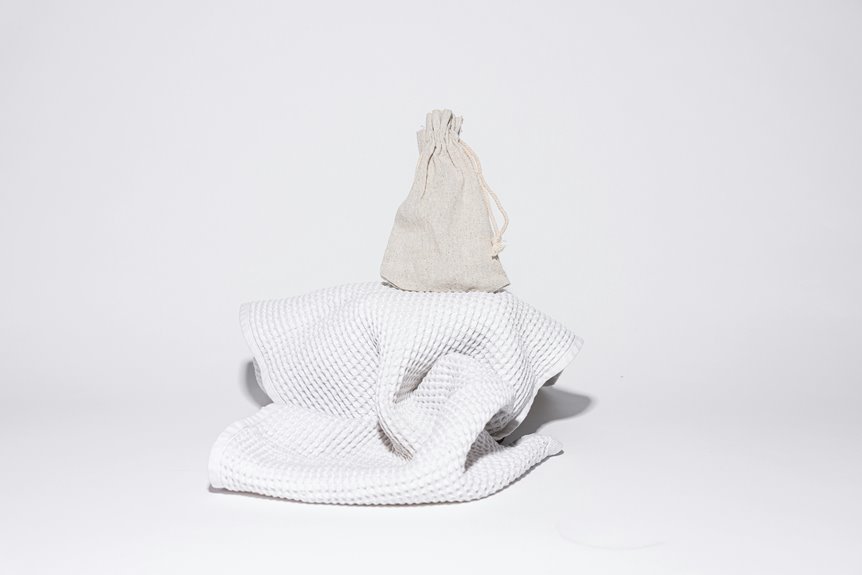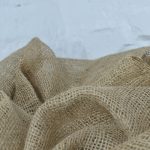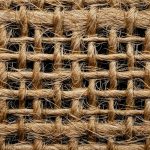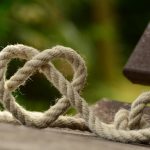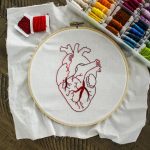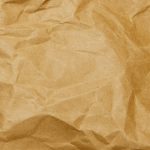You might think hessian, burlap, and jute are the same, but they differ in texture, weave, and feel. Hessian is a soft yet durable fabric with a looser weave, burlap is coarser and denser, while jute fibers can vary from smooth to rough, depending on use. Each offers unique strengths for projects, from rustic charm to flexibility. Knowing these distinctions helps you pick the perfect fabric—there’s more to explore about their origins, care, and eco-friendly benefits.
Table of Contents
Key Takeaways
- Hessian is a loosely woven, durable fabric made specifically from jute fibers with a rough texture, ideal for heavy-duty uses.
- Burlap is a coarser, denser fabric traditionally made from jute, hemp, or flax, featuring a tighter weave and rustic appearance.
- Jute fabric is softer and shinier with finer fibers, offering more flexibility and varying weave tightness depending on its use.
- Hessian typically costs more due to its finer weave and durability, while burlap is generally the cheapest and most widely available.
- All three fabrics are biodegradable, eco-friendly, and require dry storage and gentle cleaning to prevent mold and extend lifespan.
Origins and History of Hessian, Burlap, and Jute
The story of hessian, burlap, and jute starts centuries ago, rooted in practical uses and cultural traditions.
You’ll find that these fabrics originated primarily in South Asia, where jute plants thrived along riverbanks. People began weaving jute fibers into strong cloth to carry goods and protect crops.
As trade expanded, hessian and burlap became common terms in Europe and North America, often used interchangeably for similar coarse fabrics. You’ll notice that these materials served as reliable, affordable options for sacks, upholstery, and industrial applications.
Their durability and breathability made them essential for farmers, merchants, and artisans alike.
When you explore their history, you’ll see how these humble fabrics evolved from simple utility to valued materials in various industries worldwide.
Understanding the Material Composition
You’ll want to start by recognizing the different fiber origins and types that make up hessian, burlap, and jute.
Understanding how these fibers are woven helps you see why each material behaves the way it does.
Plus, knowing the difference between natural and processed fibers lets you choose the right fabric for your needs.
Fiber Origins and Types
Although these materials often get mixed up, understanding their fiber origins helps you distinguish between Hessian, Burlap, and Jute.
Each fabric comes from natural plant fibers but varies in source and type:
- Jute: Derived from the jute plant, it’s soft and shiny, mainly grown in India and Bangladesh.
- Hessian: Often used interchangeably with burlap, Hessian specifically refers to fabric made from jute fibers.
- Burlap: A coarser fabric traditionally made from jute but sometimes from other fibers like hemp or flax.
- Other fibers: Burlap may include hemp or flax blends, affecting texture and durability.
Knowing these origins helps you pick the right fabric based on texture, strength, and use without confusing their names.
Weaving Techniques Explained
Since weaving techniques directly impact a fabric’s texture and durability, understanding how Hessian, Burlap, and Jute are woven helps you choose the best material for your needs.
All three typically use a plain weave, where fibers cross over and under each other in a simple crisscross pattern. This technique creates a sturdy, breathable fabric with a coarse texture.
However, the tightness of the weave varies: Hessian usually has a looser weave, giving it more flexibility, while Burlap tends to be denser and rougher. Jute’s weave can range from loose to tight, depending on its intended use.
Natural vs. Processed Fibers
Understanding how Hessian, Burlap, and Jute are woven gives you insight into their texture and durability, but the fibers themselves play an equally important role in their performance.
These materials all come from natural fibers, primarily jute plants, but the degree of processing impacts their strength, appearance, and environmental footprint.
When you choose between them, consider:
- Natural Fibers: Minimally processed, retaining more of the plant’s original qualities.
- Processed Fibers: Treated to improve softness, color, or durability but may lose some natural strength.
- Environmental Impact: Natural fibers tend to be more eco-friendly due to less chemical use.
- Texture and Strength: Processing can make fibers smoother but might reduce their robustness.
Knowing this helps you pick the best material for your specific needs.
Differences in Weave and Texture
You’ll notice each fabric uses a distinct weaving technique that impacts its strength and appearance.
The texture varies from coarse to slightly smoother, affecting how the material feels to the touch.
Understanding these differences helps you choose the right fabric for your project.
Weaving Techniques Compared
Although hessian, burlap, and jute often get mixed up, their weaving techniques set them apart in both feel and function.
When you look closely, each fabric’s weave influences durability and flexibility, which is key for your project’s needs.
- Hessian uses a plain weave, creating a tight, strong fabric ideal for heavy-duty tasks.
- Burlap also features a plain weave but with a looser structure, making it breathable yet less durable.
- Jute fibers are woven tightly with a balanced weave, offering a smoother finish than burlap.
- The thread thickness varies, affecting texture and strength; hessian often uses thicker yarns than jute or burlap.
Understanding these differences helps you pick the right fabric for durability and appearance.
Texture Variations Explained
Texture plays an essential role in distinguishing hessian, burlap, and jute beyond their basic weave patterns.
When you examine hessian, you’ll notice its coarse, open weave gives it a rough, almost rustic texture that’s ideal for durability.
Burlap, while similar, tends to have a slightly tighter weave, resulting in a more uniform texture with less visible gaps.
Jute fabric varies more, often feeling softer and smoother due to finer fibers and sometimes a looser weave.
As you handle these materials, you’ll see the weave density and fiber thickness directly affect how each fabric looks and behaves.
Understanding these subtle texture variations helps you choose the right fabric for your project, ensuring both appearance and function meet your needs.
Material Feel Differences
The feel of hessian, burlap, and jute changes noticeably when you run your hand across their surfaces, thanks to differences in weave and fiber thickness.
Each material offers a unique tactile experience that can influence your choice depending on the project.
- Hessian: Coarser weave with thicker fibers, giving it a rugged, textured feel.
- Burlap: Usually rough and loosely woven, making it slightly stiffer and less flexible.
- Jute: Smoother and finer fibers, resulting in a softer, more pliable texture.
- Weave Density: Hessian and burlap have a more open weave, while jute’s tighter weave feels less coarse.
Common Uses and Applications
You’ll find hessian, burlap, and jute used in a variety of practical and decorative ways, thanks to their durability and natural appeal.
You can use them for garden sacks, upholstery, and packaging because they protect items while allowing airflow. If you’re into crafts or home décor, these materials make excellent rustic table runners, wall hangings, and gift wraps.
Gardeners often rely on them for erosion control and plant protection. You might also see burlap and hessian used in landscaping or as backing for carpets.
Jute, being softer, suits fashion accessories like bags and hats. Whether you’re working on a DIY project or need a strong, breathable fabric for storage, these materials offer versatile, eco-friendly options without sacrificing style or function.
Environmental Impact and Sustainability
Because hessian, burlap, and jute are made from natural fibers, they offer significant environmental benefits compared to synthetic alternatives.
When you choose these materials, you’re supporting sustainability and reducing your ecological footprint.
Here’s why they stand out:
- Biodegradability: They break down naturally, minimizing landfill waste.
- Renewable Resources: Made from plants like jute and hemp, which regrow quickly.
- Low Energy Production: Their manufacturing uses less energy than synthetic fabrics.
- Carbon Sequestration: Growing the plants absorbs CO2, helping combat climate change.
Care and Maintenance Tips
When handling hessian, burlap, or jute, proper care guarantees they last longer and maintain their natural charm. Keep them dry to prevent mold and mildew, and avoid overexposure to sunlight to reduce fading. Spot clean with mild soap and cold water, then air dry flat to preserve texture. Store in a cool, ventilated place to retain freshness.
| Care Tip | Why It Matters |
|---|---|
| Keep Dry | Prevents mold and mildew |
| Spot Clean Gently | Maintains fabric integrity |
| Store Ventilated | Avoids musty odors and damage |
Cost Comparison Between the Fabrics
Understanding how to care for hessian, burlap, and jute helps you protect your investment, but knowing their cost differences can guide your purchase decisions.
Generally, these fabrics are affordable, but prices vary based on quality and availability. Here’s a quick cost comparison:
- Hessian tends to be the most expensive due to its finer weave and durability.
- Burlap is usually cheaper and widely available, making it a budget-friendly choice.
- Jute fabric costs fall between hessian and burlap, reflecting its versatile use.
- Custom finishes or eco-friendly certifications can increase the price of any fabric.
How to Choose the Right Fabric for Your Project
How do you decide which fabric suits your project best? Start by considering the fabric’s texture and durability.
If you need something rough and sturdy for heavy-duty use, Hessian or burlap works well. For a softer, more flexible option, jute might be the way to go.
Think about the environment too—if your project will be outdoors, choose a fabric that resists moisture and mildew.
Also, factor in the look you want; burlap offers a rustic charm, while jute can appear more refined.
Finally, check your budget since prices vary.
Frequently Asked Questions
Can Hessian, Burlap, or Jute Be Dyed Easily?
You can dye hessian, burlap, and jute quite easily since they’re natural fibers. Just use fabric dye designed for natural materials, and make sure to follow instructions for even color and long-lasting results.
Are These Fabrics Waterproof or Water-Resistant?
You might think these fabrics repel water, but they don’t. Hessian, burlap, and jute absorb moisture easily, so they’re neither waterproof nor truly water-resistant. You’ll need to treat them for any water protection.
Do These Fabrics Attract Pests Like Insects or Rodents?
You might find these fabrics attract pests since their natural fibers appeal to insects and rodents. To protect your items, you’ll want to store them properly and consider treatments that repel pests and prevent damage.
Can These Fabrics Be Used in Food Packaging?
When you think of nature’s gift wrapping, you’ll find these fabrics can safely package dry foods, but watch out—they’re porous and not moisture-proof, so you shouldn’t use them for wet or perishable items without a protective liner.
Are There Any Health Concerns When Handling These Fabrics?
You might experience skin irritation or allergies when handling these fabrics, especially if you’re sensitive to natural fibers. Always wear gloves and wash your hands afterward to avoid any discomfort or potential health concerns.
- Using Jute Fabric for Bag Making: A Complete Guide - June 28, 2025
- The Ultimate Guide to Jute Erosion Control Fabric for Landscaping - June 28, 2025
- Jute Fabric for Sofa Upholstery: Is It a Good Choice? - June 28, 2025

